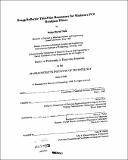Bragg reflector thin-film resonators for miniature PCS bandpass filters
Author(s)
Naik, Rajan Sharad
DownloadFull printable version (11.75Mb)
Advisor
Rafael Reif.
Terms of use
Metadata
Show full item recordAbstract
Thin-Film Resonator (TFR) based bandpass filters are an economically attractive alternative to current dielectric filters. TFR based filters are orders of magnitude smaller and can potentially be manufactured on-chip, thereby allowing VLSI integration of bandpass filters into a RF portable radio circuit. TFR based bandpass filters can easily meet and even exceed current specifications for the 1.8GHz PCS band bandpass filters. High quality VLSI compatible piezoelectric films are an essential component of a TFR. Aluminum Nitride is the preferred material because its constituent elements are VLSI compatible. The AIN film quality strongly affects the TFR, and thus filter bandwidth as well as the filter insertion loss. A de magnetron sputtering system was heavily modified to deposit high quality, polycrystalline AIN films at temperatures of approximately 150°C. Rockjng Curves of 2.3° on Si substrates and 5.5° on thin-film Al substrates were achieved. Due to the relatively low deposition rate of AlN, and the required low deposition temperature, the AlN film quality was found to be limited by the oxygen content. For a deposition rate of lµm/hr. and a deposition temperature of 150°C, an oxygen containing partial pressure of less than approximately lxl0·10 torr is necessary for narrow Rocking Curve material. In any deposition system, there will be film thickness non-uniformities across the wafer. These thickness variations resuit in resonating frequency variations. For a 3-3 ladder bandpass filter consisting of two different TFRs, a thickness resolution of better than 0.4% is needed. Consequently, a highly accurate, in-situ thickness measuring tool is required. Spectroscopic Phase Modulated Ellipsometry (SPME) was demonstrated as a potential thickness measurement tool. Several AIN films were measured using SPME. Thicknesses were extracted with a measurement accuracy of less than 0.1 %. The AlN refractive index was also measured using SPME. A strong correlation was observed between the index of refraction and the AlN Rocking Curves. Thus, SPME can be implemented in-situ as a non-destructive process monitoring tool. Since the piezoelectric properties of AlN strongly determine the filter figures of merit, it is essential to know how these properties vary with the AlN Rocking Curve. A simple acoustic device, the ovennoded resonator, and a new model, the Lossy Resonator Model, were developed specifically to extract the one-dimensional, bulk AIN electromechanical coupling constant K2 as a function of Rocking Curve. For Rocking Curves less than 3.5°, K2 is relatively constant, and approaches the value for bulk, epitaxial films. Based on this data, the maximum possible TFR bandwidth is approximately 40MHz, well above the 25-30MHz brutdwidth required for PCS applications. Essentially, the TFR and thus filter bandwidth is not limited by the AlN film quality. Several Bragg Reflector TFR devices were fabricated and tested. Sputtered SiO2 and AINOx were used as the low and high acoustic impedance materials respectively. The best devices have a bandwidth of approximately 3.6%, or 25MHz and a Q of 400. The low figures of merit are attributed to low acoustic mirror reflection coefficient caused by inaccurate mirror materials thicknesses and acoustic properties. Simulation results indicate that if the acoustic properties are well known and reproducible, acceptable bandwidths and Q's can easily be attained even for acoustic and thickness variations of 5-10%. The effect of temperature on Bragg Reflector TFRs was also investigated. The thermal coefficients of frequency for both a packaged ('off-chip') and unpackaged ('integrated') device were measured to be approximately -35ppm/°C for the series resonance and -15ppm/°C for the parallel resonance. The shift in frequency with temperature is attributed mainly to thermal expansion of the TFR constituent materials. The bandwidth was found to either increase or decrease with temperature, depending on whether thermal expansion resulted in thicknesses closer to or further away from a quarter-wavelength. In either case, the thermal coefficient of bandwidth magnitude was approximately 0.1 %/°C. The device Q was found to decrease with increasing temperature. This effect is attributed to the Akhieser mechanism. In addition, a slight hysteresis was measured. The Q values after the temperature cycling were approximately 5% lower than the Q values before temperature cycling. The hystersis effect is attributed to microcracks formed as a result of stress relief within the TFR device structutre. For manufacturing considerations, all of the measured thermal coefficients are probably sufficiently small to neglect.
Description
Thesis (Ph.D.)--Massachusetts Institute of Technology, Dept. of Materials Science and Engineering, 1998. Includes bibliographical references (p. 193-199).
Date issued
1998Department
Massachusetts Institute of Technology. Department of Materials Science and EngineeringPublisher
Massachusetts Institute of Technology
Keywords
Materials Science and Engineering